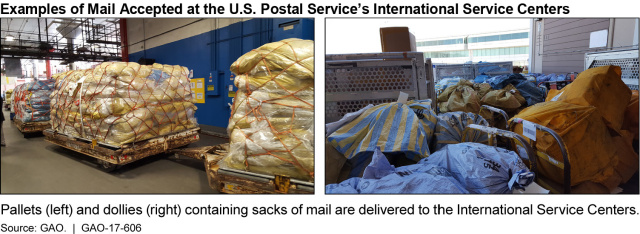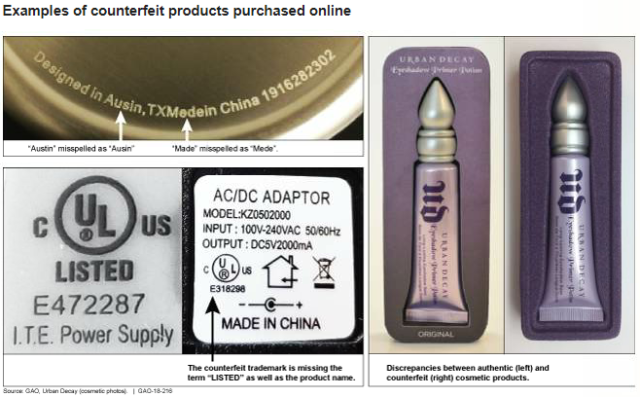Are Your Online Purchases Legit?
More counterfeit goods, drugs, and other illegal or prohibited items may be entering the United States as people increasingly buy things online. So, today’s WatchBlog explores how Customs and the Postal Service screen packages coming into the United States and what Customs does to stop counterfeit goods from reaching consumers.
Needles in a haystack
The growth in online shopping has increased the volume of international shipments—making it harder to identify packages with illegal or prohibited items. In a 2017 report, we examined how Customs and the Postal Service inspect international mail.
Customs tries to combat foreign counterfeiters by using data provided by shippers to identify high-risk packages for inspection. However, data isn’t currently available for all mail and once Customs has targeted packages for inspection, the Postal Service has to find them—inside sacks that can contain hundreds of other packages. In 2014 and 2015, Customs and the Postal Service initiated two pilot programs using this data to target small amounts of mail for inspection at one location. As of January 2017, the Postal Service was able to locate between 58 and 82 percent of the packages that Customs targeted for inspection in the pilot programs.
We recommended that Customs collect further data on its screening activities, particularly the costs and benefits of using electronic advance data to target mail for inspection. Customs and the Postal Service agreed with our findings and continue to coordinate to address our recommendations.
Fake products, real risks
Phone chargers, pharmaceuticals, and cosmetics are among the items commonly counterfeited and sold online to unsuspecting consumers. These counterfeits carry risks like electrocution or exposure to harmful chemicals. For example, counterfeit versions of contact lenses or hair straighteners could have dangerous chemicals or bacteria that can damage eyes or skin.
We bought consumer products from third-party sellers on popular consumer websites and asked the manufacturers of those products to test them for authenticity. They found that 20 of the 47 items we bought were counterfeit.
We also reviewed Customs enforcement activities and how they collaborate with companies that own the rights to these products and the websites that sell them to protect U.S. consumers. We made a recommendation to Customs to address problems we found with information sharing.
7 Tips for Limiting Your Risk of Buying Fake Goods Online
Pointers from various government agencies and consumer protection organizations:
- Look at who the seller is – is it a third party? “Fulfilled by” does not mean “Sold by.”
- Look for external information on the seller, such as a mailing address or telephone number, real-time customer service contacts, or customer reviews.
- Buy products only from authorized retailers, such as official brand stores.
- If a price seems too good to be true, it probably is.
- During checkout, only submit payment via a website beginning with https:// and look for a lock symbol in your web browser.
- Once you receive an item, look for signs that it may be counterfeit, such as irregular brand markings; missing “use by” dates, safety seals, or markings; and missing warranty information. Verify the item’s serial number by checking the manufacturer’s website.
- If you suspect you have received a counterfeit product, notify the brand owner and contact the place of purchase.
To help fight counterfeit goods and protect others:
- Report the counterfeit at http://www.iprcenter.gov/referral.
- To report an unsafe consumer product, visit http://www.SaferProducts.gov.
- For further information, consult http://www.stopfakes.gov.
These tips are also available in Appendix II in the PDF of our report on counterfeit goods.
To learn more, check out our reports and listen to our podcast on responding to changes in counterfeit goods.
- Comments on GAO’s WatchBlog? Contact blog@gao.gov.
GAO Contacts
Related Products

GAO's mission is to provide Congress with fact-based, nonpartisan information that can help improve federal government performance and ensure accountability for the benefit of the American people. GAO launched its WatchBlog in January, 2014, as part of its continuing effort to reach its audiences—Congress and the American people—where they are currently looking for information.
The blog format allows GAO to provide a little more context about its work than it can offer on its other social media platforms. Posts will tie GAO work to current events and the news; show how GAO’s work is affecting agencies or legislation; highlight reports, testimonies, and issue areas where GAO does work; and provide information about GAO itself, among other things.
Please send any feedback on GAO's WatchBlog to blog@gao.gov.









